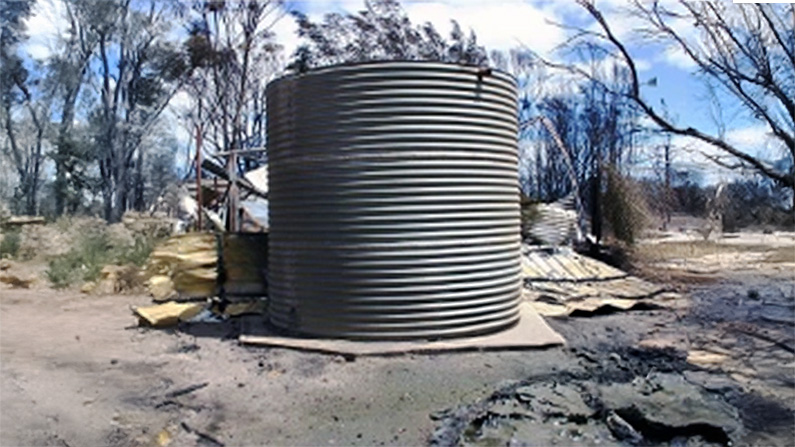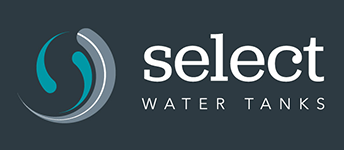
Fire Fighting Water Tank Requirements
Climate change experts are predicting an increase in the number and intensity of bushfires across Australia in the next few years. As a result of the intense bush fires across Australia in the last few years, all States have developed a set of requirements and guidelines for the storage of water in different locations.
Jump to Sections
Fire Danger Rating | | Key Documents and Resources | Water Tank Installation | Rainwater Quality in Bushfire-prone Areas
Bushfire Prone Land
The NSW Rural Fire Service (NSW RFS) has defined bush fire prone land (BFPL) as land identified by the local council which can support a bush fire or is subject to bush fire attack. They have developed bush fire prone land maps and resources such as:
- Building in Bush Fire Prone Areas
- Water Supply for Fire Fighting Purposes
In Queensland, the Queensland Fire Emergency Service (QFES) uses the terms Bush Fire Hazard Area (BFHA) interchangeably with Bush Fire Prone Areas (BFPA) and have produced different shapefiles for 13 different regions across Queensland. For example:
- Bushfire Prone Area – Wide Bay Burnett Spatial Data Format
Bushfire Attack Level (BAL) Rating System
A common feature of the requirements is the Bushfire Attack Levels (BALs) which were developed to help State and National Governments indicate to property owners and builders the different requirements for each of the different levels of bushfire risk. The six BALs based on radiant heat flux exposure threshold are as follows.
- BAL-LOW: No specific bushfire protection measures are required as the risk is minimal.
- BAL-12.5: Low risk, with potential ember attacks. Radiant heat exposure can be up to 12.5 kW/m².
- BAL-19: Moderate risk, with potential ember attacks and burning debris. Radiant heat up to 19 kW/m².
- BAL-29: High risk, with increased ember attack and radiant heat exposure up to 29 kW/m².
- BAL-40: Very high risk, with significant ember attack and potential flame contact. Radiant heat exposure up to 40 kW/m².
- BAL-FZ: Flame Zone, the highest risk, with direct flame contact and extreme radiant heat exposure above 40 kW/m².
BAL Ratings and Water Requirements
- BAL-LOW to BAL-19 (Low to Moderate Risk):
Typically, no specific water tank requirements for bushfire protection apply, though having a dedicated water supply is often recommended for added safety. - BAL-29 (Moderate to High Risk):
Properties at this level of risk may be required to have a dedicated water supply of around 5,000 litres to 10,000 litres for bushfire protection, especially in rural areas. - BAL-40 and BAL-FZ (High to Extreme Risk):
For properties with higher risk levels (BAL-40 and BAL-FZ, where FZ stands for Flame Zone), a dedicated water supply of at least 10,000 to 20,000 litres is often required.
The water supply must be accessible by the local fire authority, and a “Storz fitting” for NSW or a “Cam Lock fitting” for QLD [connected to a 50mm outlet, with ball valve] might be mandated.
BAL Ratings for Locations in Queensland
To determine the exact BAL rating for a specific location in Queensland, a site-specific BAL assessment is required. This involves examining vegetation, slope, and bushfire history near the property.
Get a step by step tutorial for identifying the Bushfire Attack Level (BAL) for your QLD property
BAL Ratings for Locations in NSW
To find out the specific BAL rating for a location in NSW, you can use the NSW Rural Fire Service’s Bush Fire Prone Land Tool, which allows you to check if a property is in a bushfire-prone area based on local council maps. Local councils may also provide BAL assessments for properties within their jurisdictions.
Get a step by step tutorial for identifying the Bushfire Attack Level (BAL) for your NSW property
Australian Standard AS3959 Construction Requirements
Buildings in areas identified as having a BAL rating must meet specific construction standards. These include:
- Use of fire-resistant materials such as metal or treated timber.
- Ember protection: sealing gaps and installing mesh screens to prevent ember attacks.
- Non-combustible materials for roofs, external walls, and windows
Key Documents and Resources
New South Wales (NSW)
- Planning for Bush Fire Protection (PBP) 2019
- Australian Standard AS3959
- NSW Bushfire Prone Land Mapping Tool
- Biodiversity Conservation Act 2016
- BASIX (Building Sustainability Index)
Queensland (QLD)
- The Queensland Government’s State Planning Policy
- Queensland Development Code MP 2.4 (Building in Bushfire-Prone Areas)
- Australian Standard AS3959
- Queensland Bushfire Hazard Area Mapping
- Bushfire Resilient Communities Guide
Get Bushfire Ready with a Fire Water Tank
With bushfire threats on the rise, it’s crucial to have a reliable water source for firefighting purposes. Whether you live in a low-risk or high-risk bushfire zone, having the right water tank setup could make all the difference in protecting your home and property.
Make sure you’re prepared. Explore our range of fire water tanks and find the right solution for your property.
Water Tank Installation for Bushfire Protection
Factors to consider when setting up a water tank in a bushfire prone area
- There needs to be a clear space around the tanks site so that there is nothing that could burn and so that the local fire service truck can get good access to the tank outlet.
- Your draw-off outlet needs to be fitted with the correct hose connections to connect to the local fire service appliances. Each State has a different fitting. For example, a Storz fitting is needed in NSW and a Camlock fitting in Qld.
- Exposed PVC pipes and fitting will melt in a fire so make sure your valves and pipe fittings are made from metal to ensure they can withstand high temperatures.
- Do not rely on an electric pump as power will most likely be cut off during a bush fire. It is best to have a diesel or petrol driven pump and your generator needs more than 1,5kVa capacity to drive the pump.
- The generator and pump should be able to pump a minimum of 400 litres per minute and must be built with shielding from high temperatures.
- You can install a dedicated water tank for firefighting purposes only or you could install a combination water tank where water can be stored for both firefighting and domestic use.
Rainwater Quality in Bushfire-prone Areas
If like many people in Australia you live in bushfire-prone areas and also happen to depend on the rainwater harvested from your roof(s) for essential living or to supplement you local municipal water supply.
Rainwater quality can become problematic as bushfires can produce large amounts of smoke, ash and other debris which can land on the roof and contaminate the rainwater being collected. Fire retardant material and fire-fighting foaming agents can also end up on the roofs and interfere with the quality of the rainwater being harvested.
Steps to Avoid Pollution of your Harvested Rainwater
- Make sure when installing the system of pipes from the guttering to the inlet on the top of the water tank that somewhere along the system, the pipes can be quickly and easily disconnected. There are a variety of leaf collection devices that could easily serve such a purpose. This prevents any material from a bushfire that has been deposited on the roof, from getting its way into the water tank and causing the water stored in the tank to be contaminated.
- As soon as there is a threat of a bushfire, dismantle the pipe(s) connected to the water tank, to prevent windblown debris and contaminants from entering the tank. If possible. It may also be best to cover the inlet and overflow fittings so that no debris gets blown into the water tank through those openings.
- After the bushfire, disconnect the pipes to the tank if you didn’t get a chance to do so before the fire.
- Use gloves to remove any debris from the roof or guttering or pipes and set about cleaning the roof. This probably means scrubbing the roof to remove resistant residues and/or contaminants. Use clean water to do this process. Using a very mild detergent may be needed but it is not recommended because if a small amount of detergent gets into water tank, then it is very very difficult to completely remove from the water in the tank. You will need to call a professional tank cleaning service if you think the water inside the tank is contaminated in any way. Ensure you take appropriate safety measures when working on the roof and gutters.
- Clean the gutters and the pipes and reconnect the pipes between the gutters and the tank and if you have a first flush device, ensure it is empty and in working order.
- The water used to flush out the debris and residue should be redirected to a place where is won’t cause any major harm or damage to the environment and the water won’t build up and become a mosquito-breeding pond.
- If it rains after the bushfire and before any disconnection and cleaning is done, then it is likely that contaminated water has already entered the tank. If this is the case then the tank will need to be emptied and cleaned and fresh clean water will need to be used to start filling the tank again.
- Check that the bushfire has not damaged the structural integrity of the metal tank. This sometimes can happen along a seam above the water line in the tank. If the structural integrity of the tank has been compromised, then you need to organize for the tank to be emptied and repaired.
Get Bushfire Ready with a Fire Water Tank
With bushfire threats on the rise, it’s crucial to have a reliable water source for firefighting purposes. Whether you live in a low-risk or high-risk bushfire zone, having the right water tank setup could make all the difference in protecting your home and property.
Make sure you’re prepared. Explore our range of fire water tanks and find the right solution for your property.

